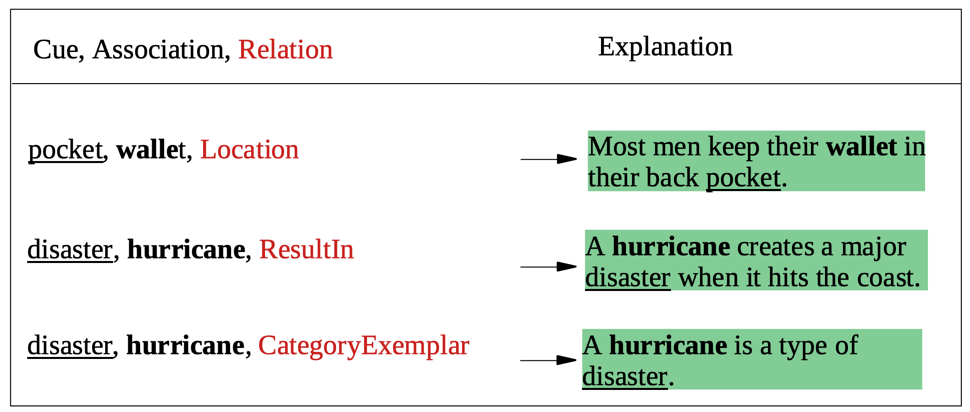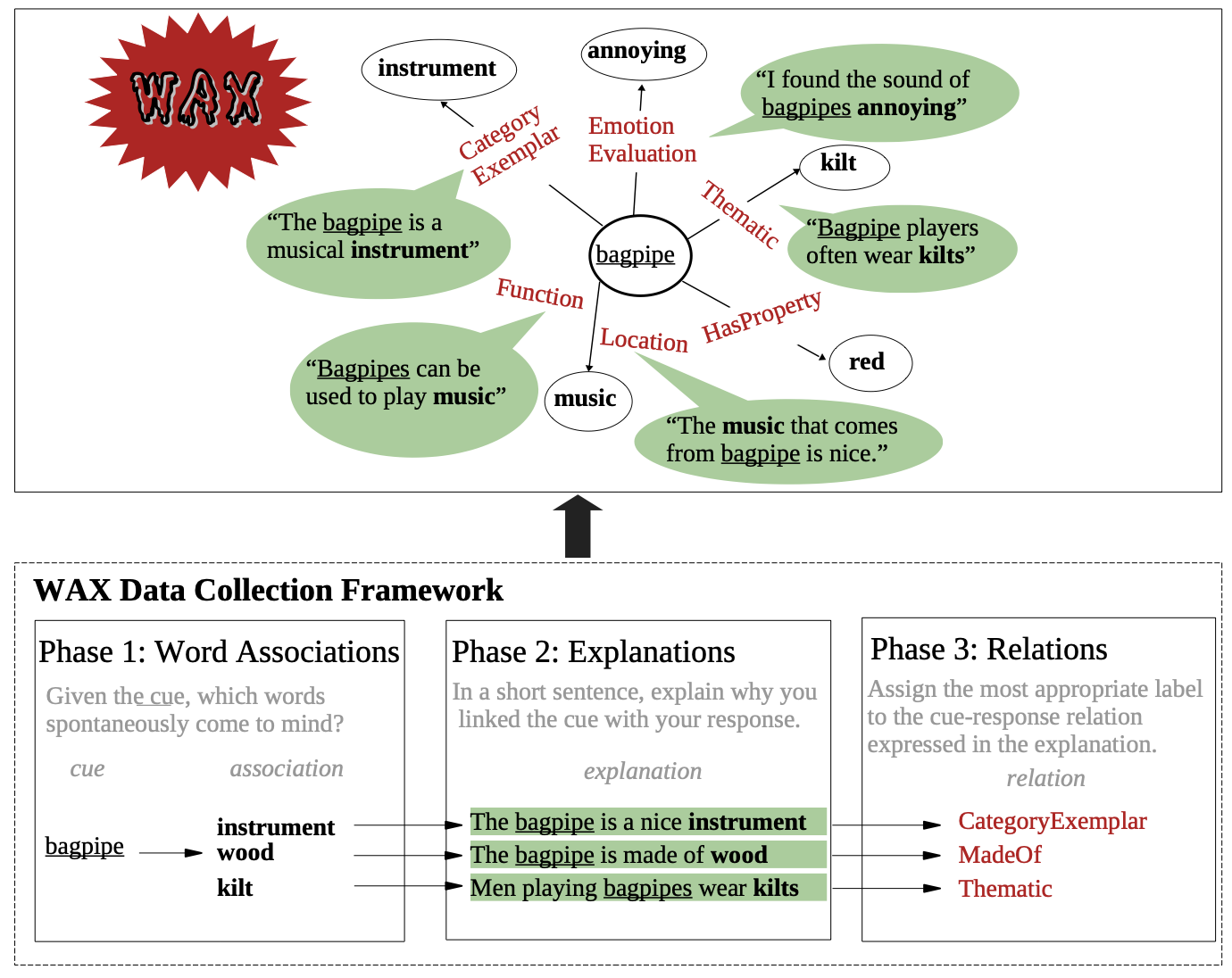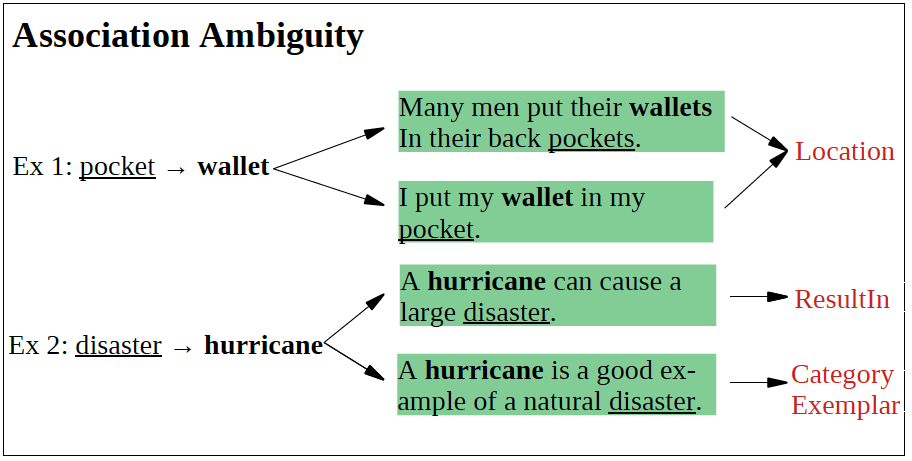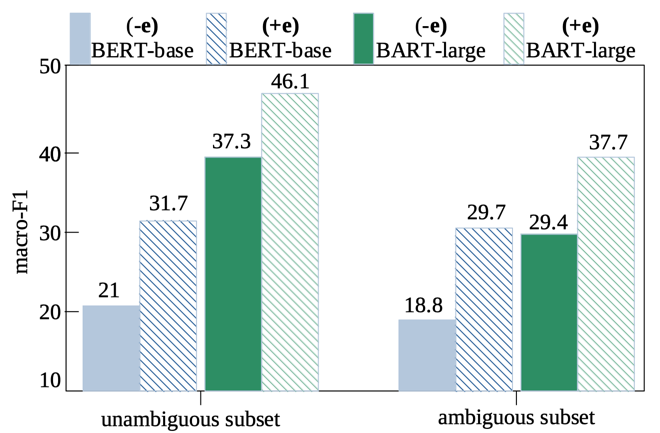WAX
This repository contains human association explanation for the WAX dataset. We present the dataset and the baselines for probing to what extent current pre-trained language models capture the underlying relations in human associations.
Introduction
Word associations are among the most common paradigms for studying the human mental lexicon. While their structure and types of associations have been well studied, surprisingly little attention has been given to the question of why participants produce the observed associations.
We introduce a large, crowd-sourced dataset of English word associations with explanations, labeled with high-level relation types. An example from WAX is shown in Figure 1 (top), bagpipe and kilt is associated is because "Bagpipe players often wear kilts." , which is labelled with a Thematic relation label. The framework for collecting WAX is shown on the bottom of Figure 1.
Figure 1: An example of bagpipe from WAX and the collection framework.
WAX consists of 1.1K cues with 1.9K explanations. A subset (1.5K) of the explanations are labelled with one of 16 association relations (e.g., Function, HasProperty). The 16 relations and their distributions are shown Figure 2:
Figure 2: The relation distribution of WAX labelled subset.
Key Challenges
Word association understanding is challenge is because:
(1) The underlying association reasons are often diverse and unknown.
(2) the uncertainty of single or multiple relations existing in the association reasons/explanations. For example, pocket and wallet are consistently associated with a single reason (Location), while hurricane and disaster are associated with different relations (ResultIn and CategoryExemplar).
Figure 3: The association ambiguity problem.
By recovering the associations reasons with explanations and labelling them with relationships, WAX allows us to study: (1) the typical underlying association reasons and (2) the relation ambiguity phenomenon, which is whether two words are consistently associated with the same relation type (relation unambiguous; Ex1) or with different relation types (relation ambiguous; Ex 2).
Repository Structure
WAX Dataset
Full WAX
You can download the full WAX dataset from WAX.csv, which includes 4 columns:
- cue: the cue concept/words that we used to stimulate participants.
- association: the association collected from participants.
- explanation: the explanation generated by a participant who associate the (cue, association) pair.
- relation: the relation label for each explanation. The value in this column is either (1) one of the 16 relation labels for explanations, which are the majority label from five annotators; (2) or UNK, which means that the relations of explanations are unlabelled.
Additional data
You can get access to the following additional data under the dataset folder:
- wax_human_auto_labelled.csv: the 1.5K relation labelled subset in WAX, including 725 instances from crowd-sourced and 836 instances labelled automatically with human verification.
- wax_human_labelled.csv: the final relation labelled subset from crowd sourcing. The label is the majority votes from five workers. Detailed labels of all five workers are provided in wax_human_labelled_all_workers.csv.
- test_wax_ambiguous.csv: the relation ambiguous subset, in which each (cue, association) pair is labelled with multiple relations.
- test_wax_unambiguous.csv: the relation unambiguous subset, in which each (cue, association) pair is consistently labelled as a single relation.
Relation Classification
The relation_classification folder contains the data and code for the task of relation classification. To assess to what extent can pre-train language models classify the word association relation with and without explanations, we employ BERT and BART to predict the mostly likely relation given:
- a (cue, association) pair (-e)
- a (cue, association, explanation) tuple (+e)
To assess to what extent models can label the relation ambiguity between words, we split our labelled subset into two test scenarios:
- unambiguous subset: (cue, association) pairs that are consistently associated with one relation label.
- ambiguous subset: (cue, association) pair that are labelled with multiple relation labels.
The experimental results are shown as follows:
Figure 4: Experimental results on the 16 relation classification task.
We observed that: (1) access to explanations improve model performance and (2) the ambiguous subset is harder to predict.
Explanation Generation
The explanation_generation folder contains the code for the task of generating explanations.
We fine-tuned BART on our data set to generate an explanation given a (cue, association, relation) triple.
Some examples are shown as follows:

Misc
Citations
@inproceedings{liu-etal-2022-wax,
title = "{WAX}: A New Dataset for Word Association eXplanations",
author = "Chunhua Liu and
Trevor Cohn and
Simon De Deyne and
Lea Frermann",
booktitle = "AACL-IJCNLP ",
month = nov,
year = "2022",
address = "Online",
publisher = "Association for Computational Linguistics"
}
Contact
Feel free to contact chunhua[dot]liu[at]student.unimelb.edu.au if you have any feedback.



